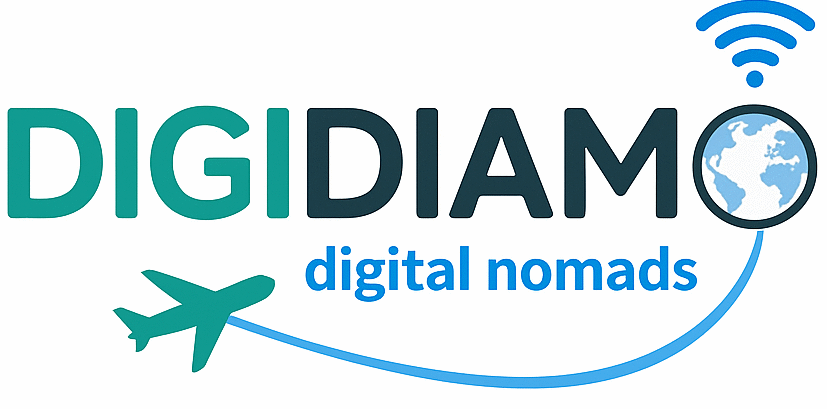Remote work tools for digital nomads in 2025
Working remotely as a digital nomad is easier than ever, but it also comes with new challenges. You carry your office in a backpack, moving from coworking hubs to guesthouses to coffee shops. To stay efficient you need more than just a laptop. The right set of tools keeps you productive, secure, and connected no matter where you are. These tools replace the office infrastructure most people take for granted. Without them, tasks slip, clients lose trust, and projects stall. For a wider context on how tools fit with jobs, routines, and destinations, the complete remote work for digital nomads guide connects every piece of the lifestyle puzzle.

Why tools matter for nomads
A digital nomad has to manage the same workload as an office employee without a stable office environment. Wi-Fi quality shifts from city to city, time zones create gaps in communication, and working solo means you must keep yourself organized. Remote work tools provide a safety net. They automate repetitive tasks, enable smooth collaboration, and protect your data from risks on public networks.
Categories of essential tools
To stay organized, it helps to group tools into categories.
- Communication and collaboration
- Project and task management
- File storage and sharing
- Finance and banking
- Security and privacy
- Productivity and focus
- Backup and internet reliability
Each category has popular options, and the best choice depends on your role and style.
Communication and collaboration
Staying in touch with teammates and clients is the foundation of remote work.
- Slack: For team messaging, channel organization, and integrations with hundreds of apps.
- Zoom: For video calls, webinars, and screen sharing.
- Google Meet: A lightweight alternative integrated with Gmail and Google Calendar.
- Loom: Perfect for recording quick video updates to replace long explanations.
Tips for nomads: Keep meetings limited and rely more on asynchronous tools like Loom or Slack. This way, you avoid working odd hours across time zones.
Project and task management
When traveling, you cannot rely on hallway chats or office reminders. Project tools make responsibilities clear.
- Trello: Visual boards for tasks. Great for freelancers managing multiple clients.
- Asana: Strong for team collaboration with deadlines and dependencies.
- Notion: Combines documents, tasks, and databases in one place. Many nomads use it as a personal HQ.
- ClickUp: A flexible platform that handles everything from docs to sprints.
The choice depends on whether you work solo or within large teams. For individual freelancers, Trello or Notion often feel lighter and easier.
File storage and sharing
Cloud storage is vital when you move between devices and locations.
- Google Drive: Affordable and widely used, integrates with Docs and Sheets.
- Dropbox: Reliable sync across devices and solid for sharing big files.
- OneDrive: Best if you use Microsoft tools.
- iCloud: Strong for Apple ecosystems, but less flexible for collaboration outside Apple users.
Always keep offline copies of critical files in case of poor internet.
Finance and banking
Getting paid globally is often the hardest part for nomads. Local bank accounts are slow to open, and fees eat into profits.
- Wise: Low-cost international transfers and multi-currency accounts.
- Payoneer: Common among freelancers for receiving payments from platforms.
- PayPal: Universal acceptance, though fees can be higher.
- Revolut: Strong for budgeting and daily spending across currencies.
Managing invoices is also easier with tools like Wave or FreshBooks. Keep a spreadsheet to track income and expenses, especially for tax season.
Security and privacy
Public Wi-Fi is a daily reality for nomads, but also a risk. Protecting your data should be non-negotiable.
- VPNs: NordVPN or ExpressVPN encrypt traffic and keep browsing safe.
- Password managers: Bitwarden or 1Password store and auto-fill logins securely.
- Antivirus: Malwarebytes or Bitdefender add another layer of safety.
Using a VPN also helps access region-locked content or tools. Always check that your VPN has a kill switch to prevent leaks if the connection drops.
Productivity and focus
Travel brings distractions, from noisy cafes to exciting new streets. Tools can help you maintain focus.
- Todoist: A simple yet powerful to-do list app.
- RescueTime: Tracks how you spend time online and blocks distracting sites.
- Forest: A playful timer app that helps you stay focused.
- Clockify: Tracks billable hours accurately for client projects.
Pair these with noise-cancelling headphones to create a bubble of focus anywhere.
Backup and internet reliability
Work cannot pause every time Wi-Fi goes down.
- Portable hotspot devices: Skyroam or Solis offer global coverage.
- Local SIM cards: Often the cheapest and fastest option.
- Offline backups: Keep a portable SSD with copies of essential files.
- Google Offline Docs: Edit and save files without internet, sync later.
Losing a client call once is unlucky. Losing it twice looks unprofessional. Backup plans save your reputation.
Comparison table of tool categories
| Category | Essential Tools | Best For |
|---|---|---|
| Communication | Slack, Zoom, Loom | Staying in sync across time zones |
| Project management | Trello, Asana, Notion | Tracking tasks, deadlines, projects |
| File storage | Google Drive, Dropbox | Access files anywhere |
| Finance | Wise, Payoneer, Revolut | Handling payments across currencies |
| Security | NordVPN, Bitwarden | Protecting data on public Wi-Fi |
| Productivity | Todoist, RescueTime | Staying focused and tracking time |
| Backup | Skyroam, local SIMs | Ensuring internet and file access |
How to build your personal toolbox
Not every nomad needs every tool. Writers may rely more on Google Docs and Grammarly, while designers need Figma and Dropbox. The best approach is to start with a light stack and add tools as your workload grows. Keep costs in mind. Subscriptions add up quickly if you pay for tools you rarely use.
Balancing online and offline
One trap many nomads face is overloading on apps. You do not need five task managers or three file storage systems. Stick to one per category to reduce complexity. Use offline habits too: a paper notebook can be a backup when your laptop battery runs low.
Real-world workflow example
Imagine a freelance copywriter traveling in Portugal. She manages tasks in Trello, stores drafts in Google Drive, tracks time with Clockify, and gets paid through Wise. She uses NordVPN at cafés and a local SIM card for backup internet. When clients ask for progress, she records a Loom update instead of scheduling late-night calls.
This system keeps her efficient without tying her to one office or time zone.
Future tools to watch
In 2025, a few trends are worth noting.
- AI-powered note-taking: Apps that transcribe and summarize meetings.
- Cloud IDEs: Developers coding directly in the browser with no heavy laptops.
- All-in-one finance dashboards: Linking invoices, tax estimates, and expenses in one place.
These tools are evolving fast, and early adopters may gain an edge.
Conclusion
Remote work tools are the backbone of a nomad career. They replace the stability of an office with systems that keep you productive, connected, and safe on the road. By building a smart toolbox and keeping it lean, you give yourself the freedom to work from anywhere without losing efficiency. If you want to go beyond tools and build habits that sustain long-term productivity, read our guide on building a productive remote work routine as a nomad.






